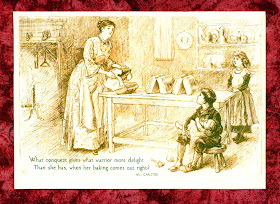“Not a moment to spare” sounds like a phrase from a fast-paced novel of suspense and close calls. It also describes the way we live our lives.
The Lady-of-the-House, knowing she was to accompany someone she loves to outpatient surgery, supplied her basket for the wait. A jar of water, an apple, her knitting, a tablet of writing paper and a book would occupy her nicely.
The couple drove passed a snowy Amish landscape thankful the roads were clear. The scenery was calming to the nerves on a day when nerves could use steadying.
Following the patient’s check-in the Lady-of-the-House left the crowded inner waiting room to sit in the outer waiting room. Only two persons were seated there at either ends of the furniture. Each was doubly supplied with electronics. The man had a laptop open but was urgently text messaging on his cell phone. The woman had a kindle in view but was fully absorbed in her hand held thingy, too.
You can imagine how old fashioned the Lady-of-the House felt – with her basket. She was suddenly struck with the thought that it is the way she’s been living for years. Time apart from her regular duties is sometimes spent doing a few rounds of knitting, reading a page of a book, or starting a handwritten letter. She may not get very far but likes to have a basket prepared for any brief opportunity.
 “Making a mitten or a sampler sounds lovely but I haven’t the time,” bemoans the dedicated, hardworking home teacher. The Lady-of-the-House is always sorry to hear this. With this post she wishes to offer help.
“Making a mitten or a sampler sounds lovely but I haven’t the time,” bemoans the dedicated, hardworking home teacher. The Lady-of-the-House is always sorry to hear this. With this post she wishes to offer help.
How can a home teacher, with her multi-faceted responsibilities, find time to dabble in something she longs to try? If you welcome practical advice read on. Otherwise, scroll to “Tickled Pink.”
Putting Lessons in Apple Pie Order
When a home teacher follows Miss Charlotte Mason’s “gentle art of learning” she is more apt to find time to revive personal interests. She has moments to spare. Here’s why. Many of Miss Mason’s educational principles consequently make good use of time. Let’s look at two.
Trust in Shorter Lessons.
Miss Mason insisted upon keeping lessons on all subjects short so that optimum attention was achieved, especially with what she called the disciplinary subjects, such as math and spelling. Alternate these with poetry, history, art, or nature study to keep minds bright. It isn’t the number of subjects but their duration that tires the mind.
Curriculum designers think their particular subject is of supreme importance. We are happy to have materials born out of such enthusiasm. Yet, in their enthusiasm they tend to “over-state their case.” Thus, a first-grader might be faced with a weighty math lesson one hour in length. To shorten math lessons the Lady-of-the-House reduced the number of word problems that her young child was required to complete. She also did a quick drill of concentrated effort every morning and another just before supper. A better memory of math facts was the result. (Lessons lengthen as the student matures).
Inch by inch, it's a cinch
Mile by mile, it's a trial
Mile by mile, it's a trial
Trust in Habit.
Habit draws us forward to do the “next thing.” Children will readily do what is customary. When lessons last 15, 20 or 30 minutes a young student can have a handful of subjects completed in a morning.
“I can see how useful good habits are,” one mother shares. “With math completed the children look forward to a late-morning snack, then to an episode of history with one child taking his turn at narrating it. After this refreshment, spelling is tackled automatically. Drawing or Nature Study is anticipated on certain afternoons. Part of my children’s afternoons, however, is now free time. And I relish my spare moments.”
 During the first months of home school this mother made every effort to keep to a regular schedule of short lessons. Now, with less effort, habit carries her children smoothly and pleasantly through their morning schoolwork - more smoothly than at the start of the year.
During the first months of home school this mother made every effort to keep to a regular schedule of short lessons. Now, with less effort, habit carries her children smoothly and pleasantly through their morning schoolwork - more smoothly than at the start of the year.
Tickled Pink
The Lady-of-House is happy to announce that after months of stitching, the girlhood sampler of Charlotte Bronte is framed. At first it rested on a windowsill while the Lady-of-the-House considered where to place it. “It will be a pretty-little-thing wherever it ends up,” she thought.
Following a week of indecisiveness it is finally at home near the 18th century silhouettes.
When she gazes at it the Lady-of-the-House tries to envision the author of such an intense story as Jane Eyre at six years of age, head bent embroidering her alphabet – a little girl younger than the girl in the painting of the last post who was knitting her own stocking – out necessity.
The Lady-of-the-House also finished Jane Eyre (the novel started in autumn.) She finds it interesting that the inscription young Charlotte stitched into her sampler was, so many years later, a Christian belief held strongly and lived out admirably by her main character.
After all the chapters of hard circumstance with Miss Eyre striving to live rightly. After struggling to reach sound judgments in spite of the sway of her feminine emotions. Finally, the Lady-of-the-House was able to rejoice over Jane’s happiness, her sense of belonging and opportunity to love and be loved in the end.
You never know what treasures you will uncover until you take a little time for Mother Culture.
Karen Andreola




























